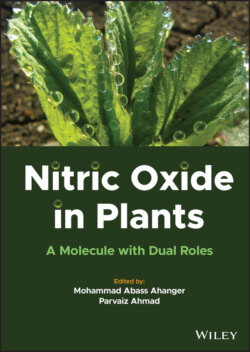Читать книгу Nitric Oxide in Plants - Группа авторов - Страница 31
2.5.4 Heavy Metals
ОглавлениеPresent industrial development has been achieved at the cost of the contamination of natural resources. The increasing concentration of heavy metals (HMs) in the environment has led to stress and toxicity for the biotic component of the ecosystem (plant, animals, and microorganisms) (Delledonne 2005). In the rhizosphere, heavy metal concentration changes the plant physiology, morphology, and cellular and biochemical functions, thus creating negative impacts on plant growth, cell division, differentiation, reproduction, photosynthesis, and antioxidant activities (Sharma and Dietz 2009).
The mechanisms of toxicity are composed of functional groups that block essential molecules, e.g. enzymes, nutrient/ion transport, polynucleotides, displacement/replacement of ions from cells, disruption of cell and organelle membrane integrity, denaturation, and inactivation of enzymes (Hall 2002). How the heavy metals affect plants and how plants tolerate these stresses are still under research (Brouquisse 2019; Syed Nabi et al. 2019). However, many research studies have validated the role of NO in relieving heavy metal stress (Solórzano et al. 2020) either produced endogenously or applied exogenously. NO can ameliorate the toxicity of heavy metal in two possible ways: (i) scavenging the ROS overproduction directly in the cell by increasing enzymatic and nonenzymatic antioxidants; or (ii) acting as a signaling molecule to modify the antioxidative expression of the gene (Verma et al. 2013; Zhao et al. 2016). Furthermore, it might change root cell wall components, which leads to increased heavy metal accumulation in plant roots, with heavy metal levels consequently decreased in aerial parts.
ROS consist of superoxide anions, H2O2, hydroxyl free radicals, and oxygen-free species (Singh et al. 2016), which are formed in various organelles (mitochondria and chloroplasts) of cells (Singh et al. 2016). Hydrogen peroxide can produce hydroxyl free radicals and oxygen-free species by Harber Weiss and Fenton reactions under heavy metals like Cu+ and Fe2+ (redox-active metals) thus causing oxidative strain in the plant.
This oxidative stress can be ameliorated by enzymatic antioxidants, i.e. catalase (CAT), superoxide dismutase (SOD), glutathione peroxidase (GPX), and ascorbate peroxidase (APX), and nonenzymatic antioxidants like ascorbic acid (AsA), glutathione (GSH), phenolic compounds, tocopherols, and other nonprotein amino acids that are capable of scavenging ROS (Zhao et al. 2016). Studies have revealed that endogenous and exogenous sources of NO can activate the production of antioxidant species both by enzymatic and nonenzymatic pathways. Different types of strategies are related to the presence of NO in the plants, e.g. protection of phospholipid bilayers, cell wall relaxation, and whole growth of plants. The main role in the maintenance of osmotic pressure, the viscosity of cytoplasm, and the protection of chloroplast membranes as well as chlorophyll pigment under heavy metal stress is played by NO (Ahmad et al. 2018; Syed Nabi et al. 2019). Induction of metallochaperones (genes in the heavy metal-associated domain) by NO has been shown to result in the site-specific and safe transport of metallic ions within the cell. Fourteen new heavy metal-associated domains have been discovered. Genes in these domains have shown distinct expression of NO donor S-nitroso-l-cysteine (CySNO) in RNA sequence-based transcriptomic studies (Imran et al. 2016; Syed Nabi et al. 2019).
Endogenous concentration of NO in a plant varies under stress depending upon factors like type of metal, plant species, specific type of tissue/organ exposed to heavy metals, exposure duration, and method of quantification of NO (Syed Nabi et al. 2019). In Arabidopsis, lead (Pb) stress leads to the overproduction of endogenous NO, which starts a chain of different catalytic reactions in peroxisomes that cause lateral root enlargement (Chen et al. 2016). Heavy metals can increase or decrease endogenous NO, e.g.in Arabidopsis exogenous melatonin reduced the Al-induced NO production, hence hindering root elongation and arresting the cell cycle (Zhang et al. 2019). However, in the case of soya bean exposure to Cd for 72 h, increased production of endogenous NO has been detected (Kopyra et al. 2006).
Both endogenous and exogenous NO application have lessened heavy metal stress in different plants including rice, wheat, pea, and many others (Bartha-Dima et al. 2005; Singh et al. 2008; Xiong et al. 2009; Zhao et al. 2016). Exogenous NO increases the pectin and hemicellulose in the root cell wall, which results in increased accumulation of Cd in the roots and a decrease of Cd in aerial parts of the plant (Bartha-Dima et al. 2005; Rodríguez-Serrano et al. 2009; Xiong et al. 2009). Ultimately, NO mediates the transportation of Cd in root cell walls and simultaneously reduces its distribution in the soluble fractions of root and leaves. This shielding effect of NO against heavy metal strain is also supported by differential production of AsA in different plant tissues (Zhao et al. 2016). Heavy metals such as Cd cause oxidative stress in plants by activating ROS in plants, which ultimately cause lipid peroxidation. In this condition NO provides a protective function by reacting with lipids, hence inhibiting the oxidation of lipids (Verma et al. 2013). The defense mechanisms of NO against heavy metal stress depend upon many factors like plant species, organ, or tissue of the affected plant, concentration of heavy metals and exposure duration, and the source of NO (in the case of exogenous NO) (Chen et al. 2016).
